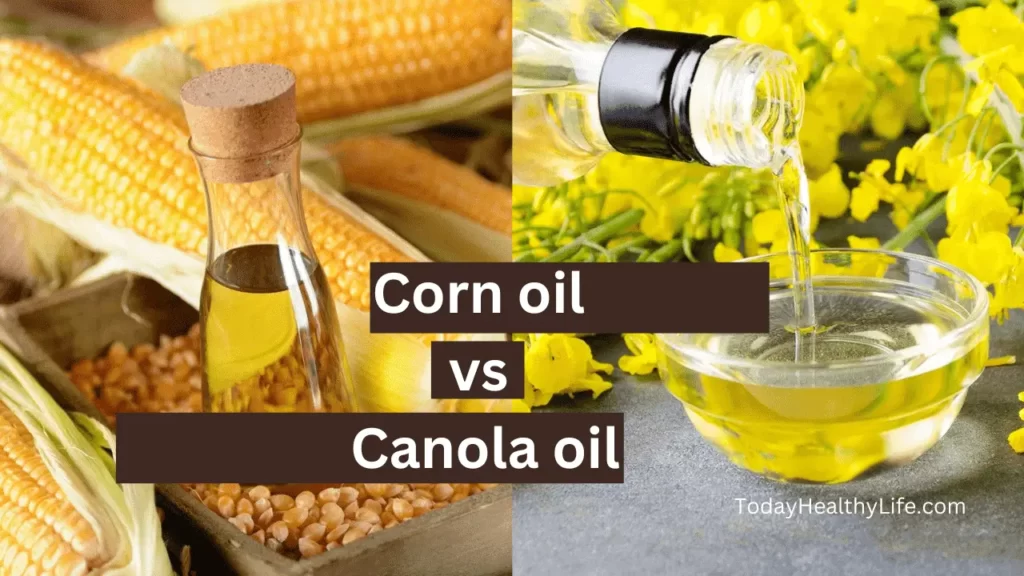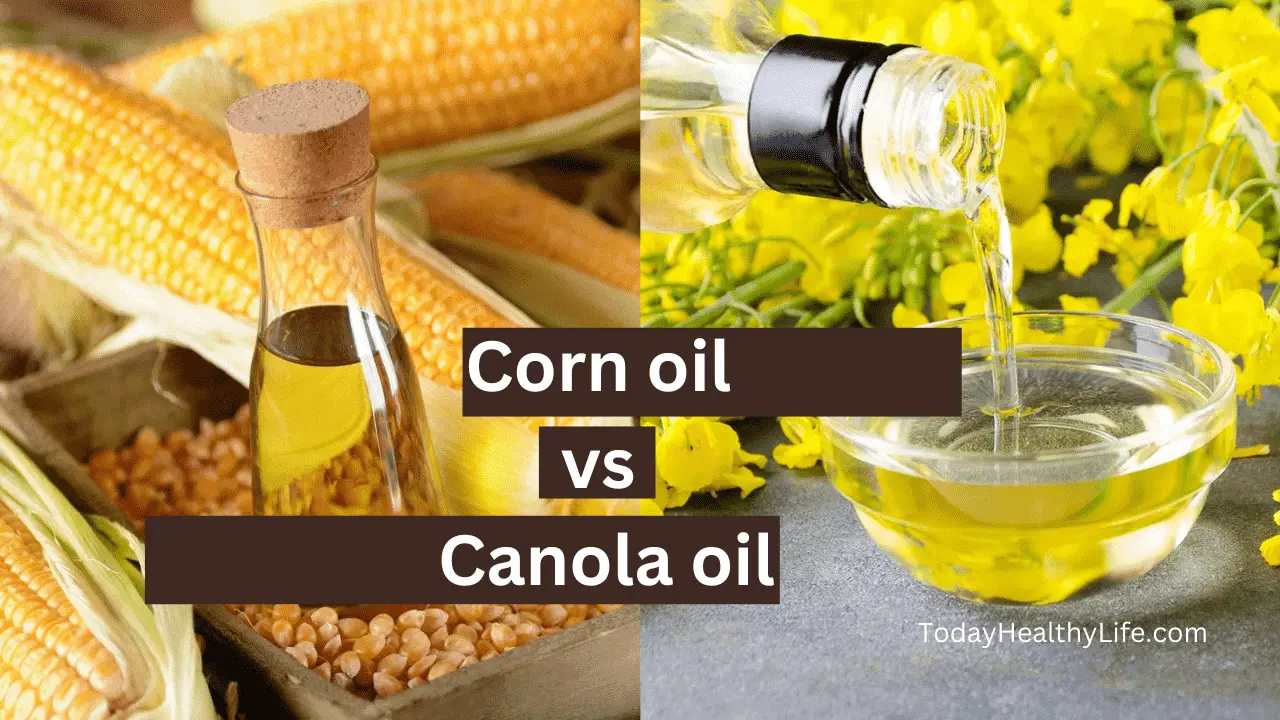When it comes to choosing the right cooking oil for your culinary adventures, the abundance of options on the market can be overwhelming.
Among the many contenders, corn oil and canola oil often stand out due to their widespread availability and distinct properties.
Both oils have their unique features and potential health benefits, but understanding their differences is essential in making an informed choice.
In this blog post, we’ll delve into the world of corn oil and canola oil, comparing their origins, nutritional profiles, cooking capabilities, and potential health impacts to help you decide which one suits your needs best.

Table of Contents
What is Canola Oil & Corn Oil?
Canola oil and corn oil are two of the most popular cooking oils in the world. They are both made from vegetable oils, but they have different nutritional profiles and smoke points.
- Corn oil is made from the germ of corn kernels. Corn oil is a good source of polyunsaturated fats, including linoleic acid. It also contains some saturated fat. Corn oil has a mild, buttery flavor and a lower smoke point than canola oil. This makes it a good choice for dishes that are cooked at lower temperatures, such as stir-fries and sauces.
- Canola oil is made from the seeds of the canola plant, which is a type of rapeseed that has been bred to be low in erucic acid and glucosinolates. Canola oil is a good source of monounsaturated and polyunsaturated fats, and it is low in saturated fat. It has a mild flavor and a high smoke point, making it a versatile cooking oil that can be used for a variety of dishes.

You can also read about:

Corn Oil vs. Canola Oil: Key Differences
Corn oil and canola oil are two popular cooking oils that are often used interchangeably.
However, there are some key differences between the two oils that you should be aware of before making a decision.
1. Origins and Processing
- Corn Oil: Derived from the kernels of maize (corn), corn oil has been a popular cooking oil for decades. The production process involves extracting the oil from the germ, which is the nutrient-rich inner part of the corn kernel. Corn oil is typically refined to remove impurities and increase its smoke point, making it suitable for high-heat cooking methods.
- Canola Oil: Canola oil, on the other hand, is a relative newcomer in the oil industry. It is extracted from the seeds of the canola plant, which is a cultivar of rapeseed. “Canola” is a contraction of “Canada” and “ola,” referring to the low levels of erucic acid present in the plant. The oil is obtained through a combination of mechanical pressing and solvent extraction, followed by refining to reduce the risk of off-flavors.
2. Nutritional Profile
- Corn Oil: Corn oil is rich in polyunsaturated fats, especially linoleic acid (omega-6 fatty acid), which constitutes a significant portion of its composition. While omega-6 fats are essential for the body, excessive consumption relative to omega-3 fats may lead to an imbalance in the diet. Corn oil also contains vitamin E, an antioxidant that helps protect cells from oxidative damage.
- Canola Oil: Canola oil boasts a more balanced fatty acid profile, which is considered healthier. It contains both omega-6 and omega-3 fatty acids in a ratio that is more favorable for human health. In fact, canola oil is one of the best plant-based sources of omega-3 fatty acids, which are known for their heart-protective benefits. Additionally, canola oil contains vitamin E and K, further contributing to its nutritional value.
3. Cooking Capabilities
- Corn Oil: Thanks to its higher smoke point, corn oil is better suited for high-temperature cooking methods like frying and sautéing. It can withstand heat without breaking down and releasing smoke, making it a preferred option for deep-frying crispy delights.
- Canola Oil: Canola oil also has a relatively high smoke point, making it versatile for various cooking techniques, including frying, baking, and grilling. Its mild flavor allows the natural taste of the food to shine through without overpowering it with additional taste.
4. Health Implications
- Corn Oil: While corn oil can be part of a healthy diet, its higher omega-6 fatty acid content has led to some concerns. Excessive consumption of omega-6 fats relative to omega-3 fats has been linked to inflammation and may increase the risk of certain chronic diseases. However, using corn oil in moderation and maintaining a balanced diet can help mitigate these concerns.
- Canola Oil: The balanced fatty acid profile of canola oil has earned it recognition as a heart-healthy option. Its rich omega-3 content can contribute to reducing inflammation and supporting cardiovascular health. The American Heart Association recommends using canola oil as part of a diet that emphasizes heart-healthy fats.
Which Oil is Right for You?
The best oil for you will depend on your individual needs and preferences. If you’re looking for an oil with a high smoke point and a neutral flavor, then canola oil is a good choice.
If you’re looking for an oil with a mild flavor that can be used to add flavor to dishes, then corn oil is a good option.
Canola oil is generally considered to be healthier than corn oil. Canola oil is higher in monounsaturated fats and omega-3 fatty acids, which are considered to be heart-healthy fats.
Corn oil is higher in polyunsaturated fats, including omega-6 fatty acids. While omega-6 fatty acids are essential for good health, too much omega-6 can lead to inflammation.
Ultimately, the best way to decide which oil is right for you is to experiment with different oils and see which one you prefer.
Here is a table summarizing the key differences between corn oil and canola oil, so that you can select easily:
| Characteristic | Corn Oil | Canola Oil |
| Polyunsaturated fat | Higher in omega-6 fatty acids | Higher in omega-3 fatty acids |
| Saturated fat | Slightly higher | Lower |
| Smoke point | Lower | Higher |
| Flavor | Mild, buttery | Relatively tasteless |
| Cost | Typically less expensive | Typically more expensive |
You can also read about: Is Canola Oil Gluten-Free?
Can You Substitute Corn Oil for Canola Oil and Vice Versa?
Yes, you can generally substitute corn oil for canola oil and vice versa in most recipes without significant issues.
Both oils are vegetable oils with relatively neutral flavors and similar smoke points, making them versatile options in various cooking applications.
However, there are a few considerations to keep in mind when substituting one for the other:
1. Smoke Point:
Both corn oil and canola oil have relatively high smoke points, which means they can withstand high temperatures without breaking down and smoking.
As a result, you can use either oil for high-heat cooking methods like frying and sautéing without much difference in the final outcome.
2. Flavor:
While both oils have mild flavors, some people may notice subtle taste differences when using one in place of the other, especially in recipes with minimal seasonings.
Canola oil is generally considered to have a slightly more neutral taste than corn oil. However, in most recipes, the flavor difference is subtle and should not significantly impact the overall taste of the dish.
3. Nutritional Considerations:
If you are specifically looking to optimize the nutritional benefits of the oil in your recipe, there are some differences to be aware of.
Canola oil has a healthier fatty acid profile, with lower saturated fat and higher monounsaturated fat content compared to corn oil.
Additionally, canola oil is a good source of omega-3 fatty acids, while corn oil is richer in omega-6 fatty acids.
If the nutritional aspect is a significant concern for your dish, consider the benefits of each oil and choose accordingly.
4. Baking:
In baking, both oils can generally be substituted for one another with minimal impact on the final product.
However, if the recipe calls for a specific type of oil for texture or taste reasons, it’s best to follow the original recipe.
For example, in recipes where a subtle corn flavor is desired, corn oil may be the better choice.
5. Allergies:
Keep in mind any potential allergies that you or your guests may have when choosing to substitute oils.
While corn oil and canola oil are not common allergens, it’s essential to be mindful of individual dietary restrictions.
In summary, corn oil and canola oil are interchangeable in most recipes, and you can substitute one for the other without significant issues.
They both have high smoke points and relatively mild flavors, making them versatile options for cooking and baking.
However, if you have specific nutritional or taste preferences, or if the recipe calls for a particular type of oil, it’s best to consider these factors before making a substitution.
Which Oil is Better for Sauteing and Frying?
When it comes to sautéing and frying, the best oil is one that has a high smoke point and a relatively neutral flavor.
Oils with high smoke points can withstand the higher temperatures used in these cooking methods without breaking down and producing smoke or undesirable flavors.
Additionally, a neutral flavor allows the natural taste of the ingredients to shine through without overpowering the dish.
Based on these criteria, both corn oil and canola oil are excellent choices for sautéing and frying.
Corn Oil for Sautéing and Frying:
Corn oil is a popular choice for sautéing and frying because of its relatively high smoke point, typically around 450°F (232°C).
This makes it suitable for high-heat cooking methods, such as stir-frying and pan-frying.
Corn oil’s mild flavor allows it to complement a wide range of ingredients, making it a versatile option in various savory dishes.
Canola Oil for Sautéing and Frying:
Canola oil is equally well-suited for sautéing and frying. It also has a high smoke point, typically around 400°F (204°C) to 450°F (232°C), which is suitable for most frying and sautéing needs.
Canola oil’s neutral flavor ensures that it won’t overpower the taste of your ingredients, making it an excellent choice for cooking a variety of dishes.
Other Suitable Oils:
In addition to corn oil and canola oil, there are other oils with high smoke points that are suitable for sautéing and frying:
- Peanut Oil: Peanut oil has a high smoke point, around 450°F (232°C), and a nutty flavor that can add a subtle taste to the dish.
- Soybean Oil: Soybean oil also has a high smoke point, usually around 450°F (232°C), and a mild flavor that won’t interfere with the taste of your food.
- Safflower Oil: Safflower oil has a smoke point around 450°F (232°C) and a neutral flavor, making it another good option for sautéing and frying.
- Sunflower Oil: Sunflower oil typically has a smoke point between 440°F (227°C) and 450°F (232°C), and its light flavor makes it suitable for frying and sautéing.
- Grapeseed Oil: Grapeseed oil has a higher smoke point, around 420°F (216°C) to 428°F (220°C), and a mild taste that works well for sautéing and frying.
Related FAQs:
Canola oil has a higher smoke point than corn oil. This means that canola oil can be used for frying and other high-heat cooking methods without breaking down and smoking.
Canola oil has a milder flavor than corn oil. This means that canola oil is a good choice for dishes where you want the flavor of the food to shine through.
Canola oil is typically more expensive than corn oil. However, the cost of both oils can vary depending on the brand and where you purchase them.
Corn oil is a good source of polyunsaturated fats, which are considered to be heart-healthy fats.
Polyunsaturated fats can help to lower LDL (bad) cholesterol and raise HDL (good) cholesterol. Corn oil is also a good source of vitamin E, which is an antioxidant that can help to protect cells from damage.
Some people worry that corn oil is high in omega-6 fatty acids, which can lead to inflammation.
However, it is important to note that not all omega-6 fatty acids are created equal.
Some omega-6 fatty acids, such as linoleic acid, are essential for good health.
Other omega-6 fatty acids, such as arachidonic acid, can promote inflammation. Corn oil is a good source of linoleic acid, but it is low in arachidonic acid.
Canola oil is a good source of monounsaturated fats, which are considered to be heart-healthy fats.
Monounsaturated fats can help to lower LDL (bad) cholesterol and raise HDL (good) cholesterol. Canola oil is also a good source of vitamin E, which is an antioxidant that can help to protect cells from damage.
Canola oil is a relatively safe oil. However, some people worry that canola oil is high in erucic acid, which can be harmful in high doses.
However, the amount of erucic acid in canola oil is relatively low, and it is not considered to be a health risk.
Conclusion
Both corn oil and canola oil have their merits, and the choice between the two depends on your specific needs and dietary preferences.
If you require an oil with a higher smoke point for frying purposes, corn oil might be the right fit.
However, for those seeking a healthier option with a balanced fatty acid profile, canola oil emerges as a clear winner.
As with any cooking oil, moderation is key, and incorporating a variety of oils in your diet can provide a broader range of nutrients.
When choosing cooking oils, always consider your overall diet, cooking methods, and individual health considerations.
It’s essential to strike a balance between indulgence and nutrition to create delicious and wholesome meals for you and your loved ones. Happy cooking!

